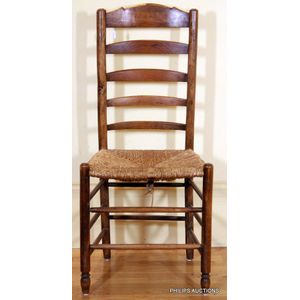19th Century Oak Ladder Back Chair
An antique oak ladder back chair, late 19th century, the square back chair with cylindrical supports, an arching crest and graduated mid-rails, a rush seat to legs with turned feet and united by multiple turned box stretchers. Height 111 cm, width 51 cm, depth 44 cm
You must be a subscriber, and be logged in to view price and dealer details.
Subscribe Now to view actual auction price for this item
When you subscribe, you have the option of setting the currency in which to display prices to $Au, $US, $NZ or Stg.
This item has been sold, and the description, image and price are for reference purposes only.
- Oak - Native to Europe and England, oak has been used for joinery, furniture and building since the beginning of the medieval civilisation. It is a pale yellow in colour when freshly cut and darkens with age to a mid brown colour.
Oak as a furniture timber was superceded by walnut in the 17th century, and in the 18th century by mahogany,
Semi-fossilised bog oak is black in colour, and is found in peat bogs where the trees have fallen and been preserved from decay by the bog. It is used for jewellery and small carved trinkets.
Pollard oak is taken from an oak that has been regularly pollarded, that is the upper branches have been removed at the top of the trunk, result that new branches would appear, and over time the top would become ball-like. . When harvested and sawn, the timber displays a continuous surface of knotty circles. The timber was scarce and expensive and was used in more expensive pieces of furniture in the Regency and Victorian periods. - Turning - Any part of a piece of furniture that has been turned and shaped with chisels on a lathe. Turned sections include legs, columns, feet, finials, pedestals, stretchers, spindles etc. There have been many varieties and fashions over the centuries: baluster, melon, barley-sugar, bobbin, cotton-reel, rope-twist, and so on. Split turning implies a turned section that has been cut in half lengthwise and applied to a cabinet front as a false decorative support.
- Rush Seating - Associated with country style chairs, stools and settees, rush seats are woven from rushes, with the pattern of the weaving often dividing the the chair seat diagonally into four triangles.
The weaving of rushes has been practiced for centuries, and it is believed that some early rush seats of the 18th and 19th century were painted, although common practice now is to leave the rush in its natural state. As the rush ages the colour
Rushes of the type used in Europe for seating are not available in Australia, and instead fibre rush, a man-made product from one-ply twisted paper, is used. Another substitute material is twisted natural sea grass.
Seats in Danish furniture of the 1950s were often finished with Danish cord, a three ply twisted paper cord, which has a similar appearance to rush.
This item has been included into following indexes:
-
chairs, singles / pairs / threes, style or period
- ladderback 63
- rush-seated 115
- Victorian, other styles 1,220
- chairs, singles / pairs / threes, timber - oak 505
Visually similar items

A George III country elm and beech ladderback armchair, the shaped arms on turned supports, six shaped rails to the back, rush seat, turned and plain stretchers to the base
Sold by
in
for
You can display prices in $Au, $US, $NZ or Stg.

Antique English country ladder back armchair
Sold by
in
for
You can display prices in $Au, $US, $NZ or Stg.

An elm rush seated rocking chair.
Sold by
in
for
You can display prices in $Au, $US, $NZ or Stg.

French country oak ladder back carver chair with rush seat
Sold by
in
for
You can display prices in $Au, $US, $NZ or Stg.
